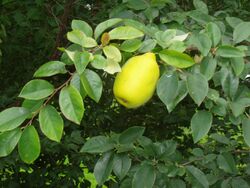Biology:Pseudocydonia
| Pseudocydonia | |
|---|---|

| |
| Pseudocydonia sinensis | |
| Scientific classification | |
| Kingdom: | Plantae |
| Clade: | Tracheophytes |
| Clade: | Angiosperms |
| Clade: | Eudicots |
| Clade: | Rosids |
| Order: | Rosales |
| Family: | Rosaceae |
| Subfamily: | Amygdaloideae |
| Tribe: | Maleae |
| Subtribe: | Malinae |
| Genus: | Pseudocydonia C.K.Schneid. |
| Species: | P. sinensis
|
| Binomial name | |
| Pseudocydonia sinensis C.K.Schneid.
| |
| Synonyms[1] | |
| |
Pseudocydonia sinensis or Chinese quince (Chinese: 木瓜; pinyin: mùguā) is a deciduous or semi-evergreen tree in the family Rosaceae, native to southern and eastern China . It is the sole species in the genus Pseudocydonia.[1] Its hard, astringent fruit is used in traditional Chinese medicine[2] and as a food in East Asia. Trees are generally 10–18 metres (33–59 ft) tall.
The tree is closely related to the east Asian genus Chaenomeles, and is sometimes placed as Chaenomeles sinensis,[3] but lacks thorns and has single, not clustered, flowers. Chinese quince is further distinguished from quince, Cydonia oblonga,[4] by its serrated leaves and lack of fuzz.
Names
In China , both the tree and its fruit are called mùguā (木瓜), which also refers to papaya and the flowering quince (Chaenomeles speciosa). In Korea the tree is called mogwa-namu (모과나무) and the fruit mogwa (모과) (from mokgwa (목과; 木瓜), the Korean reading of the Chinese characters). In Japan , both tree and fruit are called karin (花梨; rarely 榠樝) except in medicine where the fruit is called wa-mokka (和木瓜) from the Chinese and Korean names.[5][circular reference]
Characteristics
Trees grow to 10–18 m tall, with a dense, twiggy crown. The leaves are alternately arranged, simple, 6–12 cm long and 3–6 cm broad, and with serrated margin. The flowers are 2.5–4 cm diameter, with five pale pink petals; flowering is in mid spring. The fruit is a large ovoid pome 12–17 cm long with five carpels; it gives off an intense, sweet smell when it ripens in late autumn.[citation needed]
Uses
The fruit is hard and astringent, though it softens and becomes less astringent after a period of frost. It can be used to make jam, much like quince. In Korea, the fruit is used to make mogwa-cheong (preserved quince) and mogwa-cha (quince tea).[citation needed]
The fruit is also used in traditional Chinese medicine.[2]
Chinese quince is also grown as an ornamental tree.[citation needed] In Haeju, North Korea two Chinese Quinces planted in 1910 are national monuments, being probably the tallest of specimens in the country.[6]
Gallery
See also
- Flowering quinces, genus Chaenomeles
- Quince (Cydonia oblonga)
References
- ↑ 1.0 1.1 {{citation | mode = cs1 | title = Pseudocydonia | work = Germplasm Resources Information Network (GRIN) | url = | publisher = [[Organization:Agricultural Research ServAgricultural Research Service (ARS), United States Department of Agriculture (USDA) | access-date = 29 December 2017 }}
- ↑ 2.0 2.1 Lim, T. K. "Pseudocydonia sinensis." Edible Medicinal And Non-Medicinal Plants. Springer Netherlands, 2012. 515-522.
- ↑ "Chaenomeles sinensis in Flora of China @ efloras.org". http://www.efloras.org/florataxon.aspx?flora_id=2&taxon_id=200010697.
- ↑ Campbell, C.S.; Evans, R.C.; Morgan, D.R.; Dickinson, T.A.; Arsenault, M.P. (2007). "Phylogeny of subtribe Pyrinae (formerly the Maloideae, Rosaceae): Limited resolution of a complex evolutionary history". Plant Systematics and Evolution 266 (1–2): 119–145. doi:10.1007/s00606-007-0545-y. http://biology.umaine.edu/Amelanchier/Pyrinae_2007.pdf.
- ↑ :ja:カリン (バラ科)
- ↑ "Naenara Democratic People's Republic of Korea". http://naenara.com.kp/en/news/?8+417.
| Wikimedia Commons has media related to Pseudocydonia. |
Wikidata ☰ Q1334892 entry
 |





